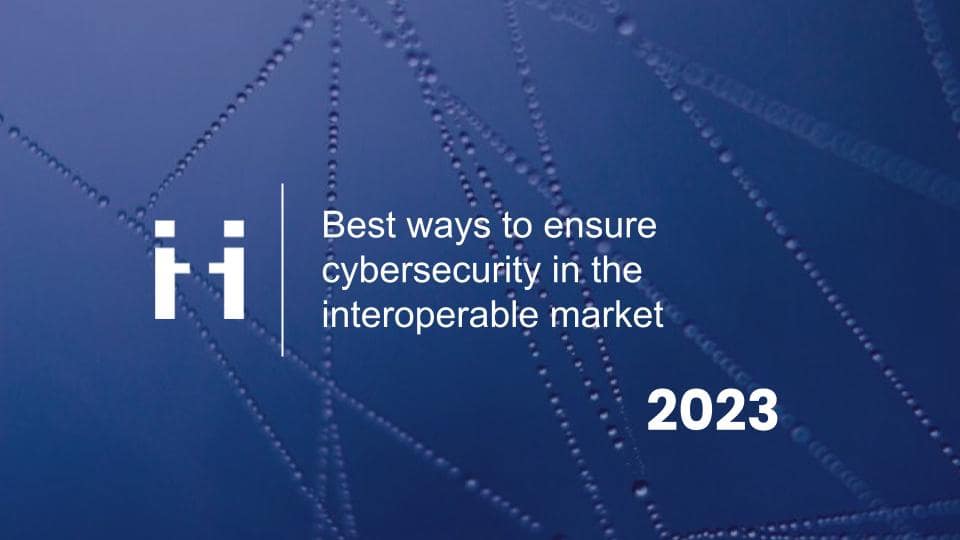
Share this article
Share this article

Globalization has made the modern digital landscape interconnected. As more and more solutions appeared, the need to have a connected environment followed suit and the concept of interoperability was introduced.
Interoperability enables the seamless exchange of data and functionality between different systems, applications, and devices. While it resulted in numerous benefits for both companies and customers, this open exchange of data has increased the importance of cybersecurity. When different solutions start “talking” and each of them has its own security standard, it becomes critical to establish a safe environment.
The purpose of this article is to provide technical professionals and industry stakeholders with an understanding of the risks associated with interoperability and the measures and strategies that mitigate those risks effectively.
It is crucial to point out that when the solutions are interoperable, it does not mean that the data is exchanged in the free flow. In fact, this exchange is governed by standards and protocols, but even such a structured system is not immune to cyber threats. Each year cybercriminals become more sophisticated and companies have to be on the lookout for new robust approaches that would allow keeping their data safe.
What are the cyber risks that the digital market faces?
Integrating systems requires establishing connections and data exchanges. Application Programming Interfaces (APIs) are designed for this purpose.
Having a well-designed API simplifies the process of program development by providing pre-established components. APIs utilize specific protocols to empower developers in rapidly building, connecting, and integrating applications on a large scale. However, if they are not implemented securely, they can become weak points in integration.
Vulnerabilities such as insecure API endpoints, lack of input validation, or insufficient rate limiting can be exploited by attackers to gain unauthorized access to the system.
Insufficient data validation during the integration process can expose systems to various risks. For instance, if input data is not properly validated, it may allow attackers to inject malicious code or execute arbitrary commands, leading to data corruption.
When integrating systems, it is crucial to establish secure communication channels to protect data exchange between them. If communication protocols lack encryption or use outdated encryption algorithms, sensitive information can be intercepted or tampered with by attackers.
Weak authentication mechanisms can create vulnerabilities in the integration process. For example, if a system relies solely on simple username and password combinations without additional layers of security, it becomes susceptible to brute-force attacks or credential theft.
There is a reason why different user roles have different privileges and access rights. The reason is cyber security. Granting excessive privileges to users or failing to revoke access rights when necessary can lead to data breaches or unauthorized modifications. It is essential to follow the principle of least privilege, where users are granted only the permissions necessary to perform their tasks, and access rights are regularly reviewed and revoked when no longer required.
As data is exchanged between interconnected systems, there is an inherent risk of data breaches or leakage. Without proper encryption and access controls, sensitive information shared during data exchanges can be intercepted or accessed by unauthorized individuals. This can result in the exposure of customer data, intellectual property, or personally identifiable information (PII), leading to severe legal, financial, and reputational consequences for the company.
Interoperable environments involve the transfer of data across various networks and systems. Without robust end-to-end encryption, there is a risk of interception or eavesdropping by attackers. End-to-end encryption ensures that data remains encrypted throughout its journey, mitigating the risk of unauthorized interception and maintaining data confidentiality.
Interoperability expands the attack surface, increasing the potential for insider threats. Authorized users with access to multiple interconnected systems may misuse their privileges to manipulate data, leak sensitive information, or disrupt operations. Implementing strong access controls, monitoring user activities, and enforcing the principle of least privilege can help mitigate these risks.
Strengthening cybersecurity must be a never-ending process for every company that wants to protect its data because each time, cybercriminals are becoming more and more sophisticated. Therefore, it is essential to, first of all, hire qualified personnel that would be able to implement robust measures. Here are several steps that can be taken to mitigate the aforementioned risks.
Implement strong authentication mechanisms, such as multi-factor authentication (MFA) or strong password policies, to validate the identities of users accessing both the remote visual support tool and the field service management software. This helps prevent unauthorized access and reduces the risk of insider threats.
Utilize end-to-end encryption for all communication channels involved in the exchange of data, including video calls and data transfers. This ensures that the information remains encrypted throughout its journey, protecting it from cyber-attacks.
Employ access controls and privilege management: implement granular access controls to restrict user privileges based on their roles and responsibilities. Regularly review and update access rights to prevent unauthorized access to sensitive data or functionalities within the integrated systems.
For example, in the case of ViiBE, each of the six user roles has a different level of authorization allowing them to see different levels of information and have access to different functionalities of the remote visual support solution.
Keep the remote visual support tool and the field service management software up to date with the latest security patches and updates. This helps address any known vulnerabilities and ensures that the software is equipped with the latest security enhancements.
Perform regular security testing, vulnerability assessments, and penetration testing on both the remote visual support tool and the field service management software. This helps identify and address any vulnerabilities or weaknesses in the systems that could be exploited by attackers.
Educate employees on cybersecurity best practices, including secure handling of sensitive data, recognizing phishing attempts, and understanding the risks associated with interoperability. Promote a culture of security awareness and ensure that employees understand their roles and responsibilities in maintaining a secure environment.
Implement robust monitoring and logging mechanisms to detect and respond to any suspicious activities or security incidents. Utilize intrusion detection systems (IDS) and security information and event management (SIEM) solutions to identify potential threats and respond in a timely manner.
Develop and regularly update incident response procedures that outline the steps to be taken in case of a cybersecurity incident. This includes containment, investigation, mitigation, communication, and recovery processes to minimize the impact of an attack and restore normal operations swiftly.
By implementing these measures, organizations can significantly reduce the risks associated with cybersecurity in interoperability. By choosing service providers that have robust strategies to ensure safety, companies become more resilient to cyber-attacks and able to profit from the seamless integration of the applications to the maximum.